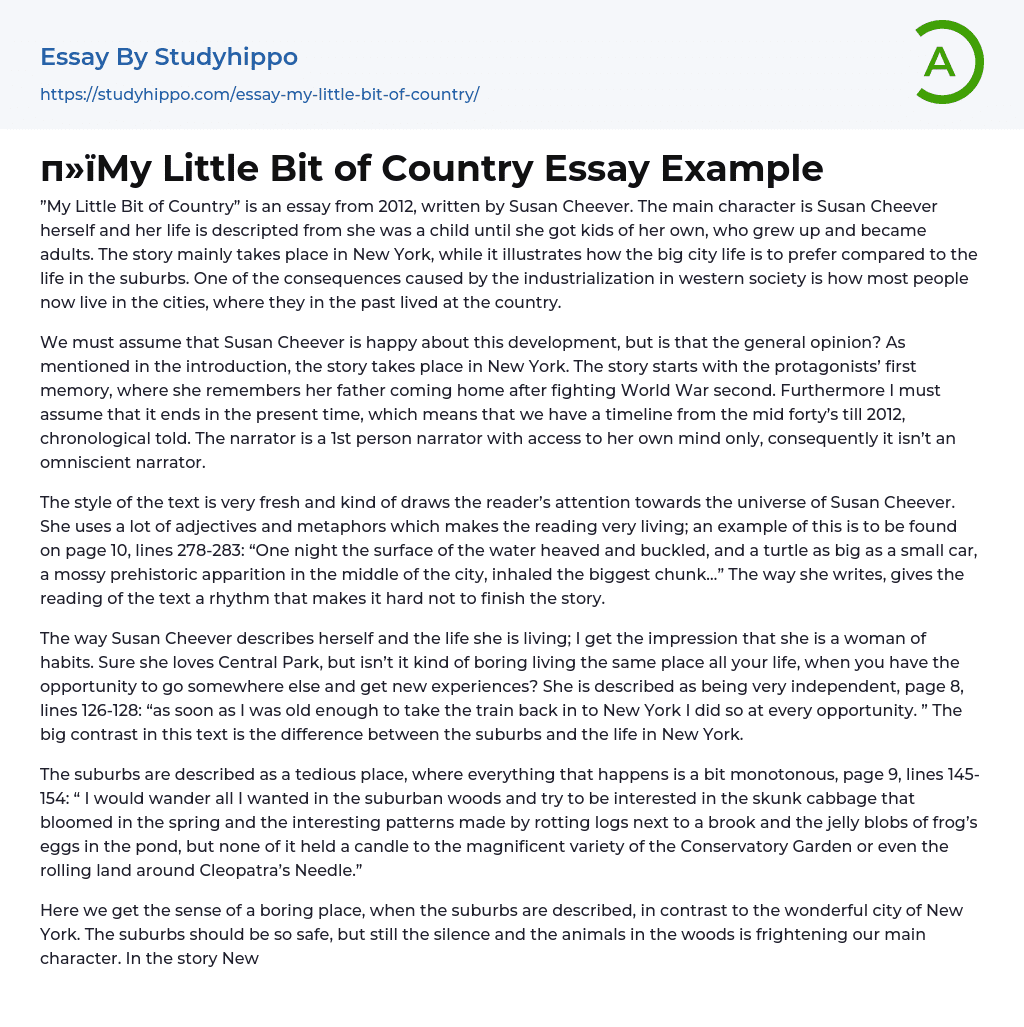"My Little Bit of Country" is a 2012 essay by Susan Cheever that centers on her personal life, chronicling her journey from childhood to parenthood. The essay's protagonist is Susan Cheever herself as she reflects on raising her children, who have since reached adulthood.
The text focuses on the city of New York and examines the differences between urban and suburban lifestyles. It emphasizes how industrialization has caused a change, with more individuals now opting to reside in cities rather than rural regions as was common before. Although Susan Cheever, the main character, seems satisfied with this shift, it is uncertain if everyone feels the same way. The story commences by describing Susan's earliest memory of her father returning home after his service in World War II.
In addition, it is assumed that the text follows a chronological narrat
...ive from the 1940s to 2012. The narrator, a first-person perspective, lacks omniscience and only has access to their own thoughts. Susan Cheever's writing style effectively engages the reader, drawing them into her world. She employs various adjectives and metaphors throughout the text, enhancing its vividness. For instance, in lines 278-283 on page 10, she describes a turtle as "a mossy prehistoric apparition in the middle of the city" and highlights its impact by stating that it "inhaled the biggest chunk..." This rhythmic writing style compels readers to continue reading until the end of the story. Moreover, Cheever's self-description and portrayal of her life reveal that she is someone who thrives on routine. While she enjoys Central Park, one may wonder if living in one place for an entire lifetime would become monotonous compared to exploring new experience
elsewhere. Furthermore, her extreme independence is evident when she seizes every opportunity to take trains back into New York City (lines 126-128 on page 8).
The primary focus of this passage is the juxtaposition between suburban life and life in New York. The suburbs are characterized as dull and tedious, even nature fails to excite the narrator with skunk cabbage, rotting logs, and frog's eggs (lines 145-154). In contrast, New York is depicted as a magnificent city with diverse attractions like the Conservatory Garden and the rolling land around Cleopatra's Needle.
While perceived as safe, the suburbs instill fear and unease in the protagonist due to silence and presence of animals in the woods. On the other hand, New York is portrayed as an enchanting wonderland for children to grow up in, offering playful fountains during summer compared to country friends who have mail-order swing sets and plastic kiddy pools (lines 168-172).
In essence, one of the central themes explored in this essay is where it would be optimal for a child to spend their formative years and experience growth.
The author reflects on her childhood in New York City and describes it as an exhilarating experience. However, there is a common belief that children have a more favorable upbringing in the suburbs. From my perspective, both choices have their pros and cons. Growing up in a bustling metropolis introduces a child to diverse cultures, which can be beneficial. Nevertheless, they may also witness early exposure to crime, alcoholism, and violence. Nonetheless, individuals raised in New York typically possess a more inclusive mindset towards those who are unlike them compared to kids brought up in suburban regions.
The main focus
of the text is the connection between society and nature, as shown through the protagonist's fascination with Central Park. The essay's title, "My Little Bit of Country," is explained by a quote from Andy Warhol found on page 9, lines 140-144. Warhol states that living in the city allows him to find a small piece of country, whereas there is no part of the city in the country. Central Park symbolizes this small part of country for the protagonist. In Denmark's era of industrialization, writers often used a romantic style to express their opposition to urban growth and the decline of nature's beauty. Although this essay was written much later, it offers an interesting perspective on industrialization.
Susan Cheever's enthusiasm for her life in New York may stem from her upbringing during the postwar period, a time when the United States had a strong belief in the future. Growing up in this era likely influenced her perspective on New York from an early age.
- Book Summary essays
- Metaphor essays
- Reader essays
- Rhyme essays
- Literary devices essays
- Villain essays
- Books essays
- Genre essays
- Literary Criticism essays
- Writer essays
- Protagonist essays
- Simile essays
- Poem essays
- Book Report essays
- Book Review essays
- Greek Mythology essays
- Plot essays
- Tragic Hero essays
- Coming of Age essays
- Play essays
- Rhetoric essays
- Rhetorical Question essays
- Translation essays
- Understanding essays
- Reason essays
- Character essays
- Letter essays
- American Literature essays
- Literature Review essays
- Utopia essays
- Poetry Analysis essays
- Dante's Inferno essays
- Between The World and Me essays
- Incidents in The Life of a Slave Girl essays
- Flowers for Algernon essays
- Myth essays
- Everyday Use essays
- Boo Radley essays
- Genesis essays
- Richard iii essays
- Alice in Wonderland essays
- On the road essays
- Ozymandias essays
- The Nightingale essays
- Holden Caulfield essays
- Animal Farm essays
- 1984 essays
- A Hanging essays
- Shooting An Elephant essays
- A Tale Of Two Cities essays




